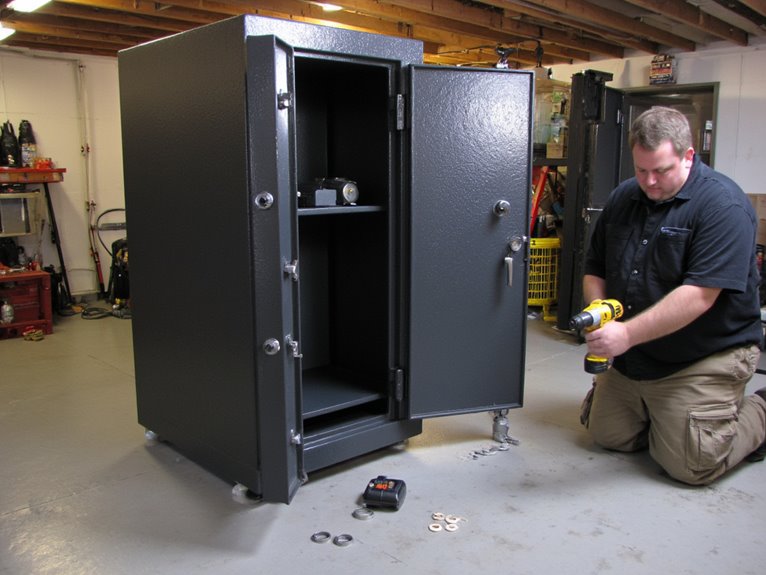How to Install and Secure a Gun Safe in Your Home
To install a gun safe properly, you’ll need to select a low-traffic area like a basement or spare bedroom with adequate structural support. Position the safe perpendicular to floor joists for even weight distribution, then anchor it using wedge anchors for concrete floors or lag bolts into wall studs. Use a 4-foot level to guarantee perfect alignment, apply shims as needed, and maintain 30-50% humidity levels with proper ventilation. The following sections provide detailed specifications for each installation step.
We are supported by our audience. When you purchase through links on our site, we may earn an affiliate commission, at no extra cost for you. Learn more. Last update on 18th December 2025 / Images from Amazon Product Advertising API.
Notable Insights
- Choose a low-traffic location like a basement or spare bedroom with low humidity and proper ventilation.
- Measure the safe dimensions and door swing radius to ensure adequate clearance in your chosen space.
- Anchor the safe using wedge anchors for concrete floors or lag bolts into wall studs for security.
- Level the safe with shims and test door operation, lock functionality, and overall stability after installation.
- Maintain 30-50% humidity levels and document installation for insurance compliance and local legal requirements.
Choosing the Right Location for Your Gun Safe
Selecting the ideal location for your gun safe requires balancing three critical factors: security, accessibility, and structural integrity.
Choose low-traffic areas like basement corners, spare bedrooms, or closet alcoves to minimize unauthorized discovery. These locations provide essential security features while reducing visibility concerns from windows and main entry points.
Basements offer excellent concealment and concrete slab support for heavy safes, though they may delay emergency access.
Bedrooms enable quick retrieval but require additional concealment measures. Avoid garages unless you’ve implemented enhanced security protocols due to elevated break-in risks.
Ensure your chosen location maintains low humidity levels and adequate ventilation to prevent firearm damage. Installing dehumidifier equipment helps maintain proper moisture control and prevents rust damage to your firearms. Similar to winter coat storage, sealed seams help protect valuable items from moisture penetration and environmental damage.
The floor must support your safe’s weight—typically 500-2,000 pounds when loaded. Position the safe perpendicular to floor joists to distribute weight more effectively and prevent structural damage.
Consider integrating the placement with existing home security systems for thorough protection. Proper anchoring prevents theft as most high-quality safes come with mounting kits for secure installation.
Preparing and Measuring Your Installation Site
Proper site preparation forms the foundation of a secure gun safe installation and directly impacts both functionality and long-term performance.
Thorough site preparation ensures optimal gun safe performance, preventing costly installation issues and long-term operational problems down the road.
Begin with thorough site cleaning by removing all obstacles, debris, and clutter from the installation area. Sweep or vacuum the floor completely to eliminate dust particles that could affect stability.
Next, conduct precise measurements verification of your safe’s dimensions—width, height, and depth—against the available space. Measure the door swing radius to guarantee adequate clearance when fully opened. Mark the exact placement location using pencil, aligning with the safe’s base dimensions and anchoring holes.
Check surface levelness using a spirit level. Uneven floors require shims or adjustments to prevent door misalignment and locking malfunctions.
Verify the floor’s load-bearing capacity can support your safe’s weight without structural damage. Most quality gun safes feature pre-drilled holes for secure wall or floor mounting to enhance security and stability.
Plan for immediate installation after delivery since heavy safes may require professionals and additional logistical coordination for doorway navigation.
Anchoring Your Safe to Floor and Wall Surfaces
Once you’ve prepared your installation site, securing your gun safe through proper anchoring becomes the critical step that transforms a heavy box into an immovable fortress. Floor anchors provide primary stability using wedge anchors or hammer-set bolts driven into concrete. Drill holes 1/4″ deeper than bolt length using masonry bits sized 3/8″ or larger. Clean debris thoroughly before insertion.
| Anchor Type | Surface | Installation Method |
|---|---|---|
| Wedge Anchors | Concrete Floor | Hammer drill, drive fully |
| Lag Bolts | Wall Studs | Pilot holes, socket wrench |
| Threaded Rods | Concrete | Epoxy adhesive system |
| Metal Plates | Soft Floors | Bolt-together assembly |
Wall mounts require lag bolts into studs, never drywall alone. Attach horizontal wood plates across multiple studs for force distribution. Tighten anchors snug plus one-half turn beyond hand-tight. Proper anchoring works alongside anti-pry designs and reinforced steel construction to create a comprehensive security system that prevents unauthorized access attempts.
Leveling and Testing Safe Functionality
After your safe is firmly anchored, achieving perfect level becomes your next priority to guarantee proper door operation and lock functionality. Use a 4-foot level across the base to identify high and low spots. Even 1/4-inch gaps can cause problematic rocking that affects security mechanisms.
Proper shim techniques involve plastic or metal shims under corners where movement occurs. Stack two layers if necessary, then trim excess material. Test door alignment by opening and closing fully – smooth operation indicates success.
Critical post-installation checks include:
- Push testing all sides – Zero movement protects your investment
- Lock mechanism verification – Your family’s security depends on reliability
- Door gap inspection – Gaps compromise fire protection
- Shelf stability confirmation – Shifting contents create dangerous situations
Recheck levelness if door binding or locking difficulties occur.
Environmental Protection and Legal Compliance
While proper installation guarantees mechanical functionality, environmental factors and legal requirements demand equal attention to protect both your firearms and legal standing.
Humidity control maintains your investment’s condition. Install dehumidifiers or silica gel packets inside your safe. Monitor levels with a hygrometer, keeping humidity between 30-50%. Position safes away from moisture-prone areas like basements, bathrooms, and garages. Electric dehumidifier rods are particularly effective for safes up to 200 cubic feet and provide continuous moisture protection with minimal maintenance. Digital hygrometers offer data logging capabilities and real-time alerts to help maintain optimal conditions for firearm protection.
| Environmental Factor | Ideal Range | Critical Actions |
|---|---|---|
| Humidity | 30-50% | Use dehumidifiers, monitor regularly |
| Temperature | 50-70°F | Avoid extreme locations, ensure stability |
| Fire/Water Protection | Rated insulation | Verify certifications, choose dual protection |
Legal requirements vary by jurisdiction but typically mandate proper anchoring and restricted access. Document your installation for insurance compliance. Confirm local regulations regarding lock types and placement standards. Use authorized locking mechanisms meeting safety codes.
Frequently Asked Questions
How Much Does Professional Gun Safe Installation Typically Cost?
You’ll pay $287 to $800 for professional service, though costs reach $2,000 for complex setups. Installation comparison shopping helps reduce expenses, as hourly rates range $50-$200 depending on your safe’s size and location requirements.
What Tools Are Required for a DIY Gun Safe Installation?
You’ll need basic hand tools like screwdrivers and wrenches, plus drill types including hammer drills for concrete. Essential installation materials include anchor bolts, safety equipment, measuring tools, and level for proper positioning.
Can I Install a Gun Safe on the Second Floor?
Yes, you can install a gun safe on the second floor, but you’ll need to evaluate second floor considerations like structural capacity and weight distribution. Professional assessment guarantees your floor can safely support the safe’s weight.
On a final note
You’ve completed the essential steps for proper gun safe installation. Your safe now provides maximum security through correct positioning, solid anchoring, and precise leveling. Regular functionality checks guarantee reliable operation of locking mechanisms and interior components. Environmental controls protect your firearms from moisture and temperature fluctuations. Verify you’re meeting all local and federal storage requirements. Your investment in proper installation delivers decades of dependable firearm security and legal compliance.

